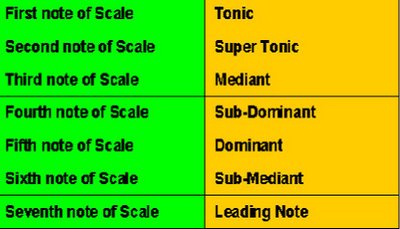Monday, May 08, 2006
Lesson-18 : Anatomy of Major Scale : Part-1
What we did in our last discussion is
-to establish an identity of a typical 7-notes group called Major scale,
- by defining the pattern of the gap between each successive notes of this Major scale.
Let us also recall that in the Lesson-16, we assign key number 1 to 13 for the Octave, including the black keys, and then find the key numbers of all the white keys which are required for the Major Scale.
So, now comes a small confusion, i.e. how to denote a key ?
One way is , whenever we want to refer, use the key number of the white+black piano keys sequencing, which is 1 to 12
Another way is, use the numbering order of the 7 keys of the Scale itself (ideally we would prefer to notify them First note of Major Scale, Second note of Major scale etc in that sequence).
In order to help the Second way, again we can use two methods, viz.
1) use the Roman numerals I to VII to denote the Seven notes of the Scale, as follows :
(Using the same table of yesterday, our Major scale on C can be represented as follows):
So we have two distinct numbering systems 1 to 12 for the Keys and I to VII for the Scale.
These Roman numerals are valid for any type of scale (including the new scales which we will learn).
I hope this is simple and clear to you!
2) The another method to denote the 7-notes of the scale is using the traditional "Naming convention" (instead of Roman Numeral or as an additional representation system along with Roman Numeral) is calling them by a special unique name for each of the key of the Scale.
(This naming system is valid for all type of scales whether Major Scale or Minor Scale which we will discuss soon ) .
These names are given below :
(for those who knows Carnatic system, they can correlate them to the special words used in Carnatic to denote 7 swarams (notes) as Shadjam, Rishabam, Gandharam , Madhyamam, Panjamam, Dhaivadham and Nishadham and shortly denoted by Sa Ri Ga Ma Pa Dha Ni )
For Clarity, I will make some more elaborations. Listen carefully :
In case of the Major Scale, starting from C, the key numbers sequences of the Seven notes are 1-3-5-6-8-10-12-(13)
And we will call each of them from first note as Tonic, second as Supertonic, third as Mediant etc etc.
Suppose imagine some other scale, which uses the keys 1-2-4-7-8-10-11-(13), which may be the combination black and white keys.
We will still call the first note as Tonic, 2nd note as Super tonic etc…..
So naming convention like Tonic, Super Tonic etc give you only the Relative reference name
whereas the exact key numbers like 1, 5, 7, 11 etc or the key names like C-D-sharp, E, F-sharp, G etc give the Absolute reference name.
To say further, take the case of the sound, note "F".
Though. this key will poduce the same sound, whatever way you call it, but in a particular scale it can be Tonic, in another scale it can be Dominant.
So, naturally, just by giving such Ralative Reference name like dominant, tonic etc, you cannot define or find the scale.
(So the same case is in Carnatic system also! … Just by saying Sa Ri Ga etc, you cannot define the Scale (Raagam) !
So you might have seen, they are using some way-out by indicating R1 D2 M2 N3 etc……as you have seen in the various technical discussions!….)
Needs a little bit concentration, that’s all, but all these are very simple concept !
Analyse it and convince yourself.. !
When we further go into deep, you will automatically understand this !
(usually when we are in High school, our ABCD is very clear (not the grammar ! ),
in College, multiplication/division is clear ….(not the Calculus ! .) .
Like that ….Don’t worry, one day we will get it…!)
Hope this is not too much for today !
